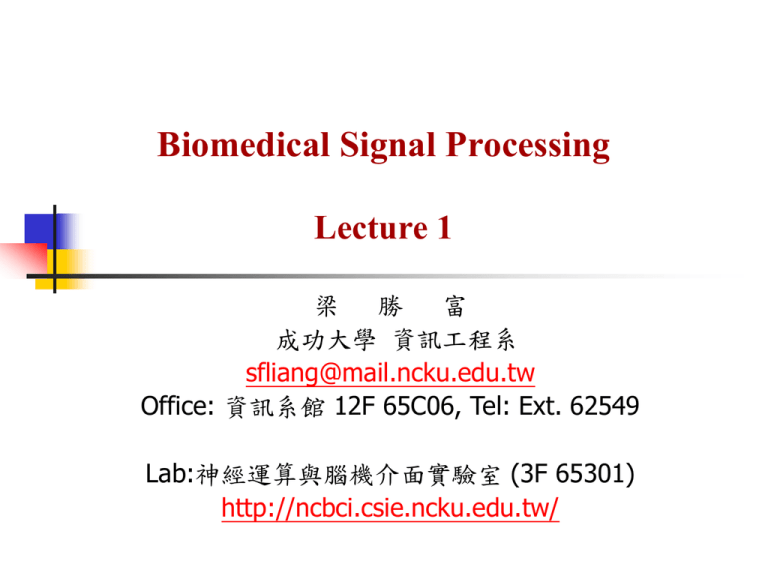Outline Nature of Biomedical Signals Biomedical Signal Analysis
advertisement

Biomedical Signal Processing Lecture 1 梁 勝 富 成功大學 資訊工程系 sfliang@mail.ncku.edu.tw Office: 資訊系館 12F 65C06, Tel: Ext. 62549 Lab:神經運算與腦機介面實驗室 (3F 65301) http://ncbci.csie.ncku.edu.tw/ Outline Nature of Biomedical Signals Biomedical Signal Analysis Ref: Chapter 1 Introduction to Biomedical Signals in Biomedical Signal Analysis, Rangaraj M. Rangayyan, Wiley, ISBN: 0-471-20811-62. 2 Nature of Biomedical Signals Living organism are made up of many component systems Nervous system Cardiovascular system Musculoskeletal system Each system carries on many physiological processes The cardiac system performs the rhythmic pumping blood throughout the body and the pulmonary system. They are accompanied by or manifest themselves as signals that reflect their nature and activities. 3 Nature of Biomedical Signals What is a signal? A signal is a single-valued representation of information as a function of an independent variable (e.g., time). 4 Example-Speech Signals “1” Channels: mono Sampling rate: 8kHz Bits (resolution): 16 bits Samples: 4409 Amplitudes: -18,000~20,000 5 Example-Speech Signals “1” Fundamental frequency: 159.4 Hz 6 Example-EEG Signals 7 Example-Blood Pressure Systolic: 收縮壓/Diastolic: 舒張壓 8 Nature of Biomedical Signals The types of biomedical signals: Biochemical: Electrical Hormones Neurotransmitters Potential Current Physical Pressure Temperature 9 Action Potential (動作電位) Action potential the basic component of all bioelectrical signals. provides information on the nature of physiological activity at the single-cell level. An excited cell displaying an action potential is called depolarized (去極化). caused by the flow of sodium (Na+), potassium (K+), chloride (Cl-), and other ions across the cell membrane. 10 The Neuron cell body (soma) Axon (軸突) Dendrite (樹突) 11 The neuronal membrane 5 nm thickness The membrane acts as a capacitor. 12 Action Potential (動作電位) Resting (polarized) Sodium (Na+) concentration inside the cell is far less than the outside. The outside of the cell is more positive than the inside of the cell. To balance the charge, additional potassium (K+) ions enter the cell, causing higher K+ concentration inside the cell than outside. Charge balance cannot be reached due to differences in membrane permeability for the various ions. A state of equilibrium is established with a potential difference, with the inside of the cell being negative with respect to the outside. 13 Action Potential (動作電位) Depolarization A cell is excited by ionic currents or an external stimulus. Membrane allows sodium (Na+) ions rush into the cell. The potassium (K+) ions leaves the cell but cannot move as fast as sodium (Na+) ions. The inside of the cell becomes positive with respect to the outside. 14 Action Potential (動作電位) Repolarization The predominant membrane permeability is for potassium (K+) ions (to leave the cell). It makes the inside more negative back to the resting potential. 15 Action potential 16 All-or-None law The action potential is always the same for a given cell, regardless of the method of excitation or the intensity of the stimulus beyond a threshold. The duration of action potentials lasts only about 3 ms because the channels are only open for a fixed period of time. (inactivation of Na+ channels) 17 Absolute refractory period After an action potential, there is a period during which a cell cannot respond to any new stimulus. 18 Examples 19 Electroneurogram (ENG) ENG is an electrical signal observed as a stimulus and the associated nerve action potential propagates over the length of a nerve. Measuring the nerve conduction velocity (NCV) of an action potential in a nerve by comparing the latencies recorded at different locations. ENG have amplitudes of the order of 10 uV. Stimulus pulse: amplitude: 100V, duration:100-300 s 20 Electroneurogram (ENG) The stimuli was applied to the ulnar nerve (尺骨神經). The grid boxes: 3ms in width, 2uV in height NCV=Distance(Belbow,Wrist)/time 21 =20.96(cm)/3.23(ms)=64.9 m/s Electroneurogram (ENG) Typical values of NCV Nerve fibers: 45-70 m/s Heart muscle: 0.2-0.4 m/s Neural disease may cause a decrease in conduction velocity. An example: the nerve conduction report 22 Electromyogram (EMG) 肌電波 Skeletal muscles are make up of collection of motor units (MUs). Motor unit (MU): Single-motor-unit action potential (SMUAP): a motorneuron, its axon (軸突), and muscle fibers innervated by that axon electrical signal of a motor unit that is the summation of the action potentials of all of its constituent cells Normal SMUAPs: biphasic or triphasic 3-15 msec in duration 100-300 V in amplitude appear with frequency in the range of 6-30 Hz 23 Electromyogram (EMG) Biphasic Triphasic SMUP trains recorded simultaneously from three channels of needle electrodes 24 Electromyogram (EMG) EMG of the muscle: spatio-temporal summation of the MUAPs of all of the active motor units. 25 Electromyogram (EMG) EMG of a normal subject. SMUAPs are mostly biphasic. Patient with neuropathy. SMUAPs are polyphasic and large in amplitude. Patient with myopathy. SMUAPs are polyphasic. 26 Chin EMG Wake REM 27 Electrocardiogram (ECG) ECG is the electrical manifestation of the contractile activity of the heart and can be recorded with surface electrodes on the limbs or chest. Two atria (心房)collect blood and two ventricles (心室) pumps out blood. The rhythm of the heart in term of beats per minute (bpm) may be easily estimated by counting the readily identifiable waves. The normal (resting) heart rate is 70 bpm. 28 Electrocardiogram (ECG) The right atrium (RA) collects impure blood from the vena cava (靜脈). During atrial contraction, the impure blood is passed to the right ventricle (RV). During ventricular systole, the impure blood is pumped out to the lungs for purification. 29 Electrocardiogram (ECG) The left atrium (LA) receive purified blood from the lungs. During atrial contraction, the purified blood is passed to the left ventricle (LV). During ventricular systole, the oxygenated blood is pumped out to the body through the aortic valve (動脈). 30 ECG --- not recording of action potential of heart; but results from the production and conduction of cardiac action potentials 31 From Mohrman, DE & LJ Heller: Cardiovascular physiology, 2005 32 Electrocardiogram (ECG) P wave: atria contraction (心房收縮), 0.1-0.2mV, 60-80ms PQ segment: propagation delay at atrio-ventricular node (房室結),6080ms QRS wave: ventricle contraction (心室收縮), 1mV, 80ms ST segment: slow action potential of ventricular muscle cells, 100120ms T wave: ventricle repolarization (relaxation), 0.1-0.3mV, 120-160ms 33 34 35 Myocardial ischemia (心肌缺血) Right coronary artery Aorta Left coronary artery Blockage Dead muscle tissue From Campbell, et al. : Biology: concepts & connections 5th edi., 2006 Fig. 13.31 36 Electrocardiogram (ECG) Some important features of the standard clinical ECG: peak value is normally about 1mV amplifier gain used is about 1,000 recommended sampling rate is 500 Hz. filtered bandwidth is about 0.05-100 Hz (for clinical) or 0.05-500 (for high resolution). 37 Electroencephalogram (EEG) EEG measures the cortical potential (皮質 電位) of Brain. Cortical potentials are generated due to excitatory and inhibitory post-synaptic potentials (突觸後電位)developed by pyramidal neurons (錐體神經元). Scalp EEG is the average of multifarious electrical activities of many small zones of the cortical surface beneath the electrode. 38 Electroencephalogram (EEG) 39 侵入與非侵入式量測 Noninvasive-Scalp EEG (非侵入式顱外腦波) Electrocorticography (ECoG)-intracranial EEG (iEEG) (顱內腦皮質電位) Local Field Potential (顱內局部腦電位) 40 各種腦電訊號 Scalp EEG (eyes open) Scalp EEG (eye closed) Intracranial EEG (interictal, opposite of epileptic zone) Intracranial EEG (interictal, epileptic zone) Intracranial EEG (seizure) (Andrzejak et al., 2001) 41 認知功能實驗室 NuAmp NeuroScan Electrode cap Data Store Server 42 睡眠實驗室 Polysomnography 43 Electroencephalogram (EEG) 10-20 system for electrode placement Recommended by International Federation of Societies for Electroencephalography and Clinical Neurophysiology 10-20 indicates that the electrodes are placed at 10, 20, 20, 20, 20, 10 % of the total nasion-inion distance. 44 45 Electroencephalogram (EEG) The rhythm of EEG : 0.5≤f<4 Hz, deep sleep stage : 4≤f<8 Hz, beginning stage of sleep : 8≤f≤13 Hz, principal resting rhythm; eye closed : f>13 Hz, background activity in tense and anxious status 46 Event-Related Potentials (ERP) Event-related potential (ERP) represents the EEG in response to visual (light), auditory (sound), electrical, or other external stimuli. ERPs are weak signals buried in ongoing activity of associated systems Signal-to-noise ratio (SNR) improvement is usually improved by synchronized averaging and filtering. 47 Event-Related Potentials (ERP) Visual ERPs uV + P300 P100 N150 48 Event-Related Potentials (ERP) Auditory ERPs N1 N2 P2 49 Comparison of Biomedical Signals Voltage[V] 10m Respiration (呼吸率) Electrocardiogram Electromyogram ( 心電圖, ECG ) ( 肌電圖, EMG ) 1m 100μ 10μ ENG(electronystagmography, 神經電位傳導圖) Brain Waves ( 腦波圖, EEG ) 1μ Evoked Potential (Brain Wave, 誘發性腦波圖) 0.01 0.1 1 10 100 1K 10K Frequency [Hz] 50 Biomedical Signal Analysis Objectives Information gathering-measurement of phenomena to interpret a system Diagnosis-detection of malfunction, pathology, or abnormality. Monitoring-obtaining continuous or periodic information about a system. Therapy and control-modification of the behavior of a system based on the outcome of the activities to ensure a specific result. Evaluation-objective analysis to determine the ability to meet functional requirements, obtain proof of performance, perform quality control, or quantify the effect of treatment. 51 Biomedical Signal Analysis A complete biomedical signal Analysis System contains: Signal data Acquisition Sensor and transducers Amplifiers and filters Analog to digital conversion Signal Processing Filtering to remove artifacts Detection of events and components Signal Analysis Analysis of events and waves Feature extraction Pattern recognition and classification Diagnostic decision 52 Biomedical Signal Analysis Computer-aided diagnosis and therapy 53 Biomedical Signal Analysis Wireless Polysomnography and automatic sleep scoring 54 Biomedical Signal Analysis Aspects to be considered in the design of biomedical instruments Isolation of the subject or patient-avoid electrocution Range of operation-the minimum to maximum values of the signal or parameter being measured. Sensitivity-the smallest signal variation measurable. Linearity-desired over at least a portion of the range of operation. Hysteresis (遲滯)- should be corrected. 55 Biomedical Signal Analysis Aspects to be considered in the design of biomedical instruments Frequency response-most system exhibit a lowpass behavior and the compensation may be required. Stability-an unstable system could preclude repeatability and consistency of measurements. Signal-to-noise ratio (SNR)- power-line interference, thermal noise, etc., could compromise the quality of the acquired signal. A good understanding of the signaldegrading phenomena is necessary to design appropriate filtering and correction procedures. Accuracy-includes the effects of errors. 56 Biomedical Signal Analysis Difficulties encountered in biomedical signal acquisition and analysis Accessibility of the variables to measurement. Variability of the signal source. Inter-relationships in interactions among physiological systems. Effect of the instrumentation or procedure on the system. Physiological artifacts and interference. Energy limitation. Patient safety. 57 Study Chapter 1 of Biosignal and Biomedical Image Processing, John L. Semmlow, Marcel Dekker, ISBN: 0-8247-4803-4 3. 58








